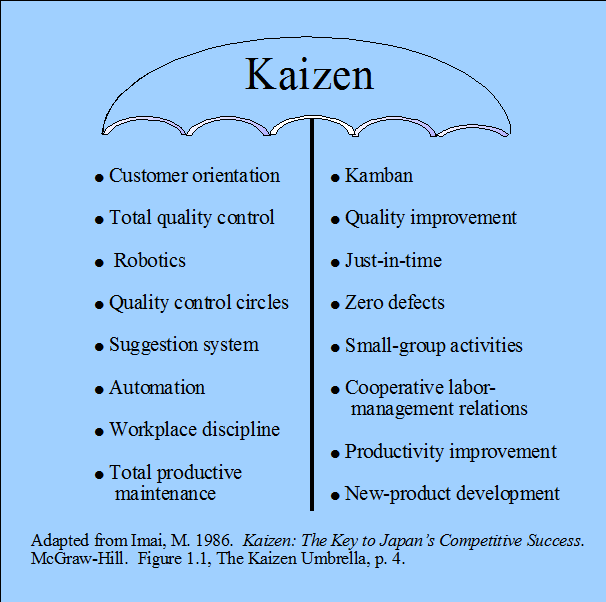
Summary by James R. Martin, Ph.D., CMA
Professor Emeritus, University of South Florida
Continuous
Improvement Main Page | Japanese Management Main Page
Chapter 1: Kaizen - The concept
Kaizen is defined as ongoing improvement involving everyone in the organization. Kaizen, according to Imai, is the basic philosophical concept underlying the best Japanese management. Kaizen is the umbrella concept that covers most of the uniquely Japanese management practices that have helped Japanese companies start from zero in the 1950s to become world class competitors in the 1980s. The graphic illustration below conveys the idea.

Kaizen management has two main components. These include improvement, and maintenance of standard operating procedures. Maintaining standards involves training and discipline. Kaizen represents small improvements in the current system, while innovation represents a significant improvement resulting from a major change such as a large investment in new technology or equipment. Everyone in the organization is involved in Kaizen from top managers who introduce, support, and build systems conducive to Kaizen, to workers who engage in Kaizen activities through suggestion systems and small group activities.
Imai discusses how Deming introduced the Plan-Do-Check-Action cycle to the Japanese in 1950, followed by Juran's seminars on concepts such as quality-control and quality circles. The Japanese used these concepts and improved on them by stressing quality product development including customer information and market research prior to the design stage. Quality control is not about inspection, but about building quality into the process. The total quality control concept in Japan is fairly broad and includes: Quality assurance, cost reduction, meeting production quotas, meeting delivery schedules, safety, new-product development, productivity improvement and supplier management. It also includes using 14 statistical tools that are listed in Appendix E: Pareto diagrams, cause-and-effect diagrams, histograms, control charts, scatter diagrams, graphs, checksheets, relations diagrams, affinity diagrams, matrix diagrams, matrix data-analysis diagrams, process decision program charts, and arrow diagrams. (See MAAW's Textbook Chapter 8 for some graphic illustrations of these statistical tools).
Imai also points out how Japanese companies are process-oriented while American companies tend to be results-oriented. Japan's process-oriented criteria places emphasis on long-term performance in contrast to the results-oriented criteria that is focused on short-term performance. A process orientation supports and stimulates improvement efforts. A results orientation focuses on carrot and stick control over short-term performance. Process-oriented thinking provides a bridge between process and results, ends and means, goals and measurements, and helps provide a whole systems view without bias. A process orientation also focuses on people related criteria such as discipline, time management, skill development, participation, morale and communication.
Chapter 2: Improvement East and West
In this chapter Imai compares the Japanese gradualist approach (Kaizen) to the great-leap-forward approach (Innovation) favored by Western companies. His discussion is based on the differences between the two approaches that are summarized in the following graphic illustration.
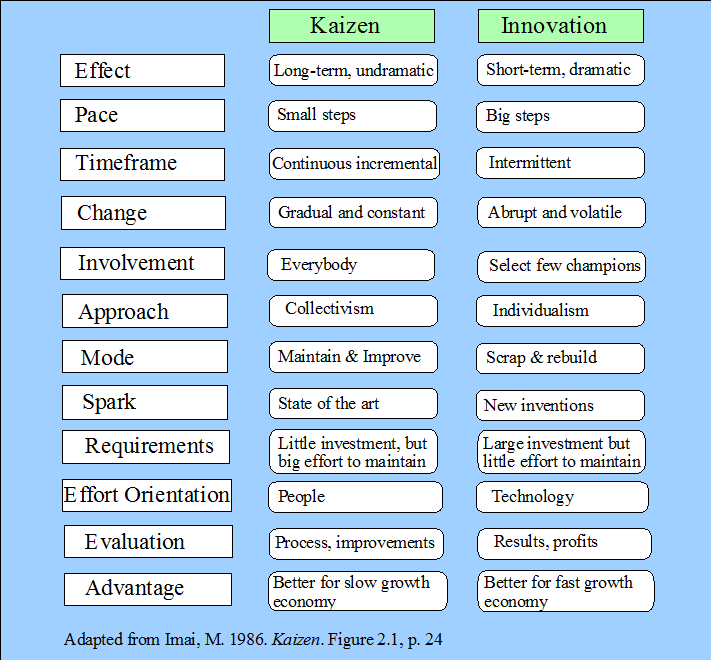
Chapter 3: Kaizen by Total Quality Control
In this chapter Imai discusses the differences between Japanese and Western approaches to quality control including six features of the Japanese approach. These include:
1. Company wide total quality control with all employees participating,
2. Emphasis on training and education,
3. Quality control circle activities,
4. Total quality control audits including the Deming Prize audit and the President's audit,
5. Application of statistical methods, and
6. Nationwide total quality promotion.
Other points include the view that total quality control depends on data, specifically data related to customers' requirements, and recognition that the next process is the customer. In addition, quality drives profits. Thus management should focus on quality, as well as quantity, delivery time, safety, cost, and employee morale. When problems occur, workers should question the previous process and ask why five times.1 Total quality control should be customer-oriented, not manufacturing oriented. When problems and defects are created upstream, the downstream customer suffers. Therefore the emphasis is on cross-functional quality management including vendors, suppliers, subcontractors as well as all internal activities.
Imai also discusses Deming's Plan-Do-Check-Action cycle2, and how the first seven statistical tools mentioned above are used with the PDCA continuous improvement approach. A graphic illustrating the concept is provided below.
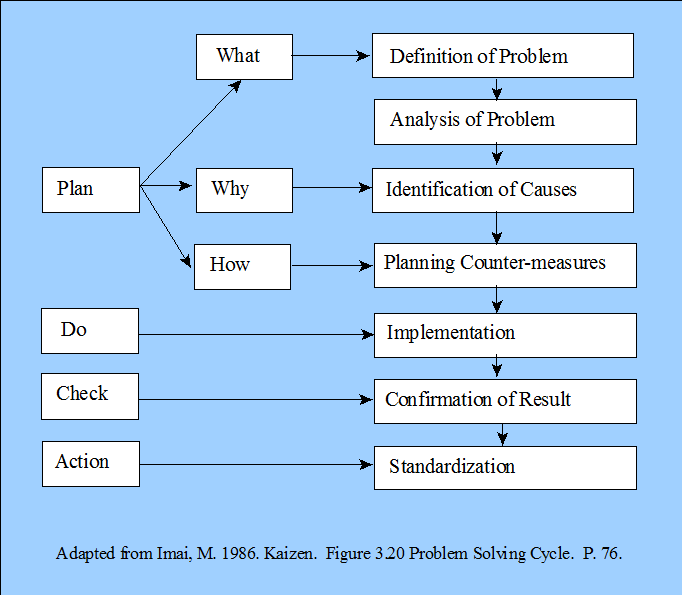
Imai also points out that improvements must be standardized. There must be standard measurements for each worker, each machine, and each process and everyone must follow the standards. Note that standardization is the action step after confirming the results of an improvement in the PDCA cycle.
There are also many other illustrations in this chapter including a case study "Reducing resign-output variation at Ricoh" that includes several illustrations such as an outline of processes, resin output histogram, cause and effect diagram, analysis of variation, and output histogram.
Chapter 4: Kaizen - The Practice
Imai discusses how Kaizen is used at different levels within the organization. He refers to these levels as three segments of Kaizen. The following graphic illustration provides a fairly good summary of the ideas presented in this chapter.
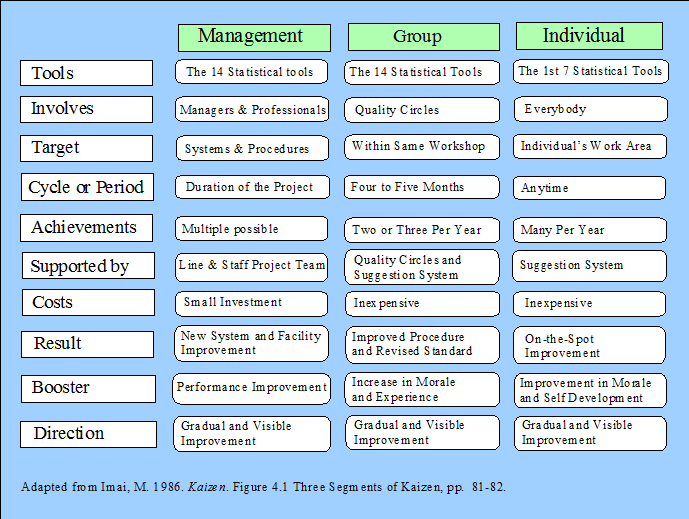
Management oriented Kaizen covers all areas of the business. The starting point is to identify waste in the way people work. Looking for ways to reduce waste in a worker's motion reflects Taiichi Ohno's motto "Use your head not your money." Management oriented Kaizen also involves improvements in the machinery and facilities, as well as systems and procedures. Even the best-designed machinery can be improved. Improvements in the factory layout involve actions such as eliminating conveyors and designing the layout to minimize movement. Another idea developed by Ohno was to design the building to fit a just-in-time, or kamban layout, rather than the other way around. Ohno's Toyota factory layout was also designed to minimize inventory to expose hidden problems. Defective work should never be sent to the next stage of production.
Ohno's production system has two main features: just-in-time and kamban. Imai describes just-in-time as a means of producing the exact number of required units at the appropriate time. The term kamban refers to a signboard or label used to communicate what is needed downstream. Jidohka is another part of the JIT system that refers to automatic-stop or self-diagnostic mechanisms that stop a machine if a defect is found. This allows workers to monitor many machines since only equipment that has stopped needs the workers immediate attention.
There are three new concepts in the area of systems improvement. These include cross-functional management, policy deployment, and quality deployment. The second set of seven statistical tools (Imai refers to them as the new seven) are used for systems improvement. Briefly the new seven are as follows:
1. Relations diagrams - Show interrelated factors in complex situations to clarify cause-and-effect relationships.
2. Affinity diagrams - Show brain-storming efforts where participants group and
realign ideas.
3. Tree diagrams - Show the interrelations between goals and measures.
4. Matrix diagrams - Used to clarify relationships between quality and production
requirements.
5. Matrix data-analysis diagrams - Add detailed information to the matrix chart.
6. Process decision program charts - Used to arrive at an optimum conclusion and
to avoid surprises.
7. Arrow diagrams - Shows the steps required to implement a plan used in PERT and
CPM projects.
Group oriented Kaizen involves quality circles, small group activities, as well as permanent and continuous use of the PDCA cycle. Team members in the quality circles identify problems, identify their causes, analyze the causes, implement and test countermeasures, and establish new standards and procedures. The idea is conveyed by the illustration below that shows a continuous PDCA cycle within the "Do" step of the broader PDCA cycle.
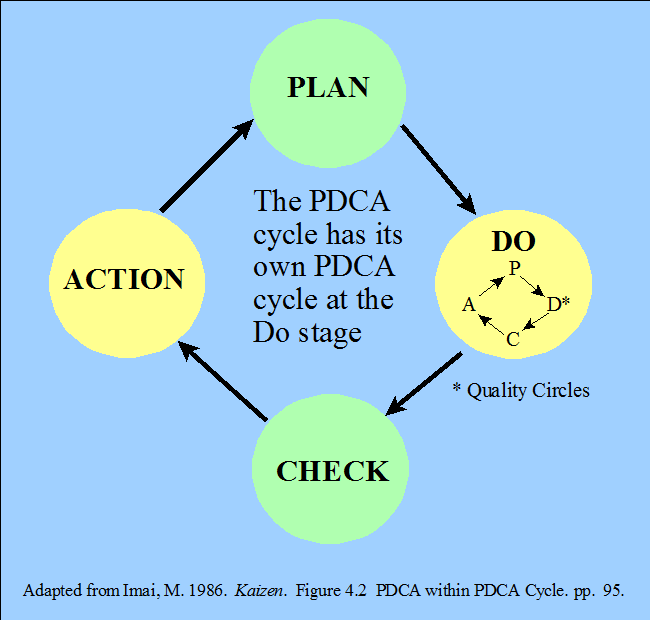
Small group activities strengthen teamwork, help members share and coordinate their roles, improves communication between workers, improves morale, helps workers develop new skills, knowledge, and cooperative attitudes, and improves labor management relations.
Individual oriented Kaizen focuses on suggestion systems and the idea that workers should work smarter, not necessarily harder. The key to success in this area is to provide workers with the education needed for quality suggestions. Workers need problem solving skills to make their jobs easier, safer, more productive, and less time and cost consuming.
This chapter also includes a number of case studies that illustrate how the Kaizen concepts are used in practice.
Chapter 5: Kaizen Management
Management includes maintenance-managing for current performance and Kaizen managing for improvement. Kaizen managing is related to cross-functional management and policy deployment. Policy deployment (Quality, Cost, Scheduling or Quality, Cost, Delivery) depends on cross-functional management as indicated in the following graphic.
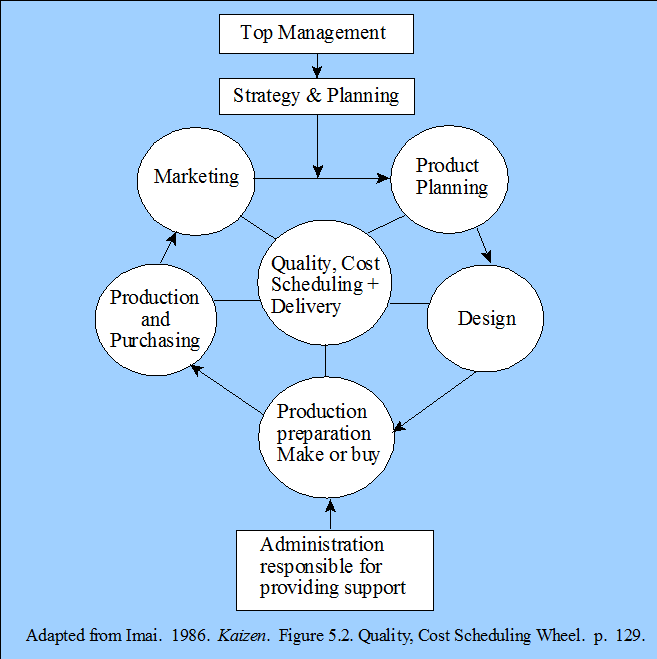
Cross-Functional Management
Although a lot of emphasis is placed on quality and cost, meeting schedules in terms of volume and delivery is perhaps even more important. Scheduling requires a tremendous cross-functional effort. Imai provides a matrix to show how cross-functional management is required for scheduling and delivery, as well as quality and cost. It shows that quality, cost, scheduling and delivery need to be considered at every stage including product planning, product design, production preparations, purchasing, manufacturing, and sales. The illustration below shows how the marketing, engineering, and production functions need to be involved at various stages of the process, rather than each function doing their part and then dumping their work onto the next function downstream.
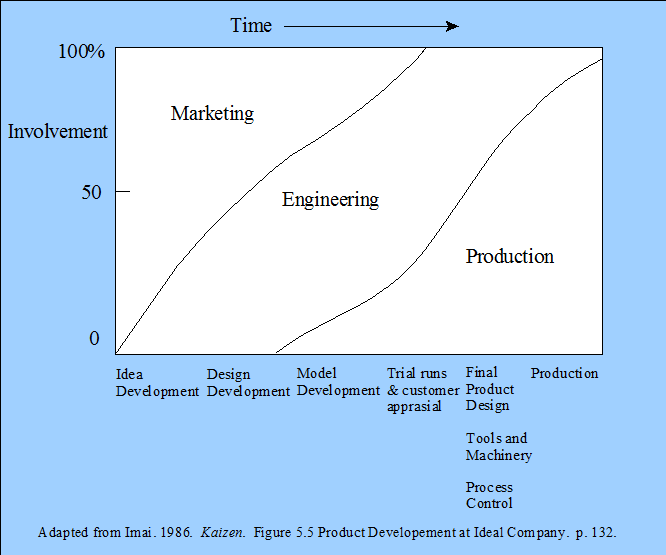
Cross-functional management emphasizes breaking interdepartmental communication barriers. Cross-functional goals come first before departmental or functional goals. Cross-functional management also includes auditing cross-functional goals and the quality, cost, scheduling process. This section of chapter 5 includes illustrations of cross-functional management at Toyota and Komatsu.
Policy Deployment
Policy deployment involves internalizing Kaizen policies throughout the company from the highest level to the lowest level where policy refers to medium to long range targets. Policy deployment also involves prioritization as indicated by a Pareto diagram. In addition, each manager's role must be clearly understood, and each manager must have a clear understanding of control points and check points established to reach the goals and targets. Imai explains how control points and check points are closely related to the use of control charts. This is followed by a fairly short discussion of statistical process control. Policies are also audited or diagnosed to help identify what might be wrong with the process or system.
Quality Deployment
Quality deployment involves developing quality deployment tables showing customer-required quality characteristics that are deployed into counterpart characteristics, that are further deployed into engineering and production requirements. Using these tables engineers maintain better communication with marketing and production people.
Total Productive Maintenance
Total productive maintenance is hardware-oriented while total quality control is software oriented. Total productive maintenance or TPM places emphasis on maximizing equipment effectiveness and preventive maintenance over the life cycle of the equipment. This effort involves everyone at every level. Three main parts of TPM include: 1) Establishing a system where everyone is involved in eliminating four causes of equipment inefficiency, i.e., breakdowns, mold troubles, tool-replacement time, and defectives; 2) Improving the maintenance crew's problem solving skills; and 3) improving production-engineering in the areas of tools, dies, tool replacement time, tool design, and defectives and repairs.
Chapter 6: The Kaizen Approach to Problem Solving
Imai starts this chapter by defining a problem and indicating how problems should be viewed if the implementation of a Kaizen strategy is to be successful. First a problem is anything that inconveniences people downstream including downstream processes as well as the ultimate customer. The thing that makes problems difficult to solve is that the people who create the problem are usually not the ones who experience the resulting inconvenience. The first step in the kaizen approach to problem is to create an environment where everyone is sensitive to the inconveniences they cause other people. Another key idea is in how a problem is viewed by everyone in the organization. A Kaizen oriented organization views problems as opportunities for improvement rather than as something to be hidden for fear of being blamed for the cause. Another related point is that most problems are cross-functional and their solutions require cross-functional cooperation.
Labor-Management Relations
Most of this chapter is devoted to a discussion of the relationships between management, labor unions and workers. Imai includes some illustrations where union rules and job classifications have prevented the possibility of implementing a Kaizen strategy. One case mentioned is where according to union rules, carpenters were allowed to remove nails, but not nuts and bolts from incoming packages at a consumer electronics show in Chicago. The carpenter's response was "That's not my job". There is no possibility of implementing Kaizen in an environment where everyone refuses to do anything beyond his or her narrow job description. Imai includes a discussion of how the NUMMI joint venture between GM and Toyota became successful when the union cooperated with management and agreed to fewer job categories and multiple job assignments. The NUMMI story reinforces the point that a joint labor-management commitment is needed where both sides are realistic and flexible in approaching Kaizen. In addition, the different unions involved must work together to enlarge and enrich the job descriptions of their members. Workers must become Kaizen conscious and this requires a change in attitude and behavior on both sides of labor-management relations. Levels and classes of employees within the organization should be deemphasized and worker participation should be encouraged. Otherwise, class antagonism will poison the environment and prevent a successful Kaizen initiative. Imai also discusses how small-group activities are used by Japanese companies to bridge the labor-management gap.
Top Management's Commitment
The main points in this section include: Quality is everybody's job and poor quality means poor management. Management's short-term results oriented thinking must be replaced with a longer-term view since Kaizen efforts take three to five years to produce results. A Kaizen strategy must come from the top. Improvement is needed in many different areas and a commitment from top management is essential to build a climate for Kaizen. Some additional points are illustrated in the following graphic.
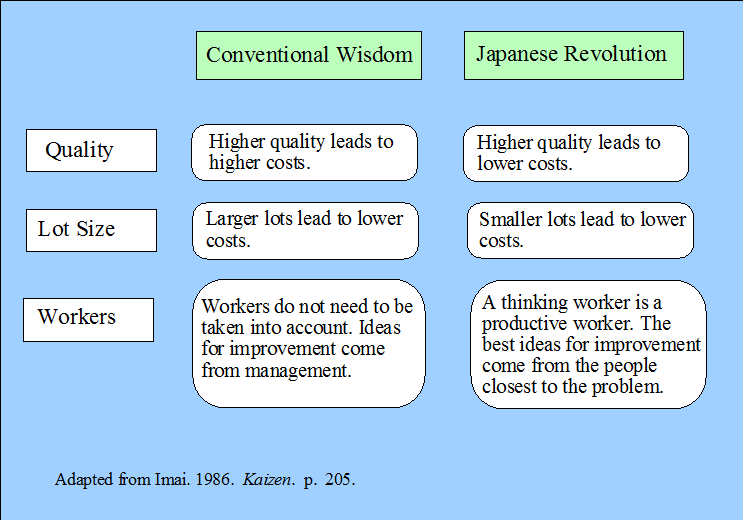
Chapter 7: Changing the Corporate Culture
In this chapter Imai discusses the need to improve supplier relations and emphasizes that a successful Kaizen strategy means customer satisfaction. Improved relations with suppliers requires more understanding of each others needs, and developing more trust between buyer and seller. Another point is that companies need to change the way they think about defects from a percentage basis to a parts per million basis. As one observer pointed out, executives who think of defects in terms of percentages belong in a museum. A Kaizen strategy requires that everyone in the organization get involved and this requires the right corporate culture. Developing the appropriate culture means constant efforts to improve industrial relations, emphasis on training workers, developing leaders among the workers, small-group activities, recognition for worker's Kaizen efforts, and bringing discipline to the workshop.
Imai defines corporate culture as "factors of industrial structure and psychology that determine the company's overall strength, productivity, and competitiveness in the long term; such factors include organizational effectiveness, industrial relations, and the capacity to produce quality products economically." Managers who are mainly concerned with short-term profits will be reluctant to spend time improving the company's culture. Kaizen requires a commitment from top management and everybody else in the organization.
Many concepts and techniques have been developed by Japanese companies using a Kaizen strategy including a customer oriented philosophy, the PDCA cycle, cross-functional management, policy deployment, process oriented thinking, and tools such as systems diagrams, and quality tables3. These concepts, techniques and tools are also applicable in business organizations in other countries and in nonprofit and government organizations as well. The goal is for the Kaizen strategy to be applied, not only in business organizations, but in all institutions and societies all over the world.
_____________________________________________
1 See a couple of Five whys examples.
2 See the PDSA graphics for other illustrations of the PDCA or Plan-Do-Study-Act approach.
3 Some other related topics and links:
Related summaries:
Baggaley, B. and B. Maskell. 2003. Value stream management for lean companies, Part I. Journal of Cost Management (March/April): 23-27. (Summary).
Baggaley, B. and B. Maskell. 2003. Value stream management for lean companies, Part II. Journal of Cost Management (May/June): 24-30. (Summary).
Deming, W. E. 1993. The New Economics For Industry, Government & Education. Cambridge: Massachusetts Institute of Technology Center for Advanced Engineering Study. (Summary).
Goodson, R. E. 2002. Read a plant - fast. Harvard Business Review (May): 105-113. (Summary).
Martin, J. R. Not dated. Lean concepts and terms. Management And Accounting Web. LeanConceptsandTermsSummary.htm
Martin, J. R. Not dated. Profit Beyond Measure graphics and notes. Management And Accounting Web. JohnsonBromsGraphicsNotes.htm
Martin, J. R. Not dated. Summary of the 1992 PBS Program Quality or Else. Management And Accounting Web. QualityOrElse.htm
Martin, J. R. Not dated. What is lean accounting? Management And Accounting Web. LeanAccounting.htm
Martin, J. R. Not dated. What is Six Sigma? Management And Accounting Web. SixSigmaSummary.htm
Spear, S. and H. K. Bowen. 1999. Decoding the DNA of the Toyota production system. Harvard Business Review (September-October): 97-106. (Summary).
Spear, S. J. 2004. Learning to lead at Toyota. Harvard Business Review (May): 78-86. (Summary).
Staats, B. R. and D. M. Upton. 2011. Lean knowledge work: The "Toyota" principles can also be effective in operations involving judgment and expertise. Harvard Business Review (October): 100-110. (Summary).
Swank, C. K. 2003. The lean service machine. Harvard Business Review (October): 123-129. (Summary).
Womack, J. P. and D. T. Jones. 1994. From lean production to the lean enterprise. Harvard Business Review (March-April): 93-103. (Summary).
Womack, J. P. and D. T. Jones. 1996. Beyond Toyota: How to root out waste and pursue perfection. Harvard Business Review (September-October): 140-144, 146, 148-152, 154, 156, 158. (Summary).